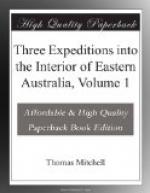NATIVE HUTS.
There were also permanent huts on both banks, the first of the kind I had seen, large enough certainly to contain a family of 15 persons; and in one there had recently been a fire. They were semicircular and constructed of branches of trees, well thatched with straw, forming altogether a covering of about a foot in thickness, and they were well able to afford a ready and dry shelter in bad weather. In this respect the inhabitants of that part of the Darling may be considered somewhat before their brethren further eastward as rational beings. These permanent huts seemed also to indicate a race of more peaceful and settled habits, for where the natives are often at war such habitations could neither be permanent nor safe. The river was here itself again, and not contracted as at the last encampment.
INTERVIEW WITH THE RED TRIBE.
June 23.
Early this morning the natives were heard hailing us from the woods, and as soon as I had breakfasted I advanced to them with Burnett. They were seventeen in number, and five or six of the foremost held out green boughs. I also pulled one, but they called to me and beckoned me to lay aside my sword, which I accordingly did, and then they all sat down. They had good, expressive countenances, but they were not strong-looking men. One, whose physiognomy I thought very prepossessing, and much improved by the cheeks and other features being coloured red, appeared to be their chief. He sat in the middle of the front row, and though he said but little yet he was addressed by the more forward and talkative. This rough, manly, rosy-faced fellow was such a figure as Neptune or Jupiter are usually represented; he had also a flowing beard. The group were almost all marked with the smallpox. I could not gain any certain information from them about the course of the river or the bearing of the nearest sea; but they all pointed to the north-north-west when I made signs of rowing in water, or of large waves, etc. On quitting them I presented the king with a greyhound pup and a tomahawk. A total ignorance of the nature of the latter was a proof that we were indeed strangers to them; for, although the tool had a handle, they knew not what use to make of it until I showed them. We left them quite delighted with both gifts, which were doubtless as important to them as the discovery of a sea would then have been to me. The journey of this day opened prospects the most promising for such a discovery, for the river from that bend pursued a more westerly course. Ranges beyond ranges arose also in the south-west, while vast plains, without any indication of the Darling among them, extended before us to the west-south-west. I had some trouble indeed to get as near to the river as was indispensable for encampment; but at length we halted on a firm bit of ground, close to a very sharp bend in its course.
HOW TO AVOID THE SANDY HILLS AND SOFT PLAINS.




